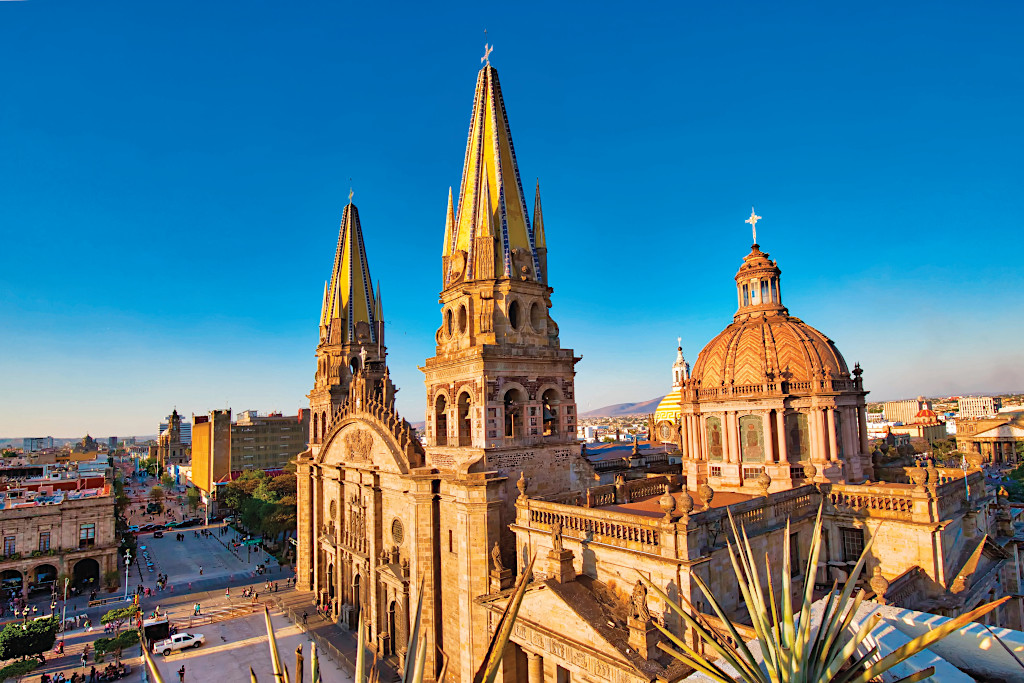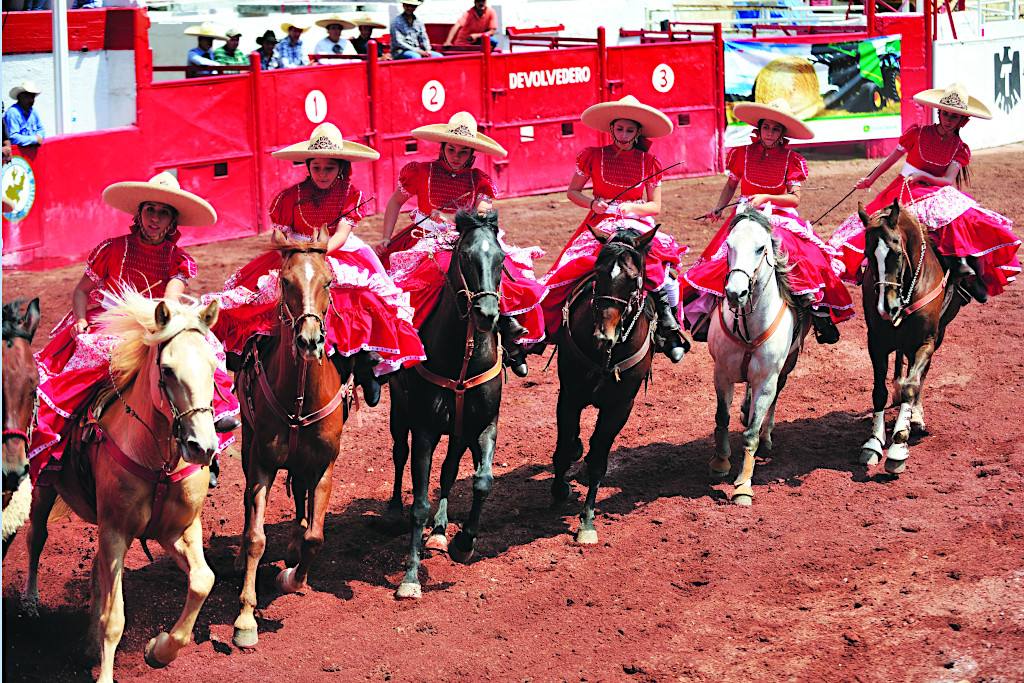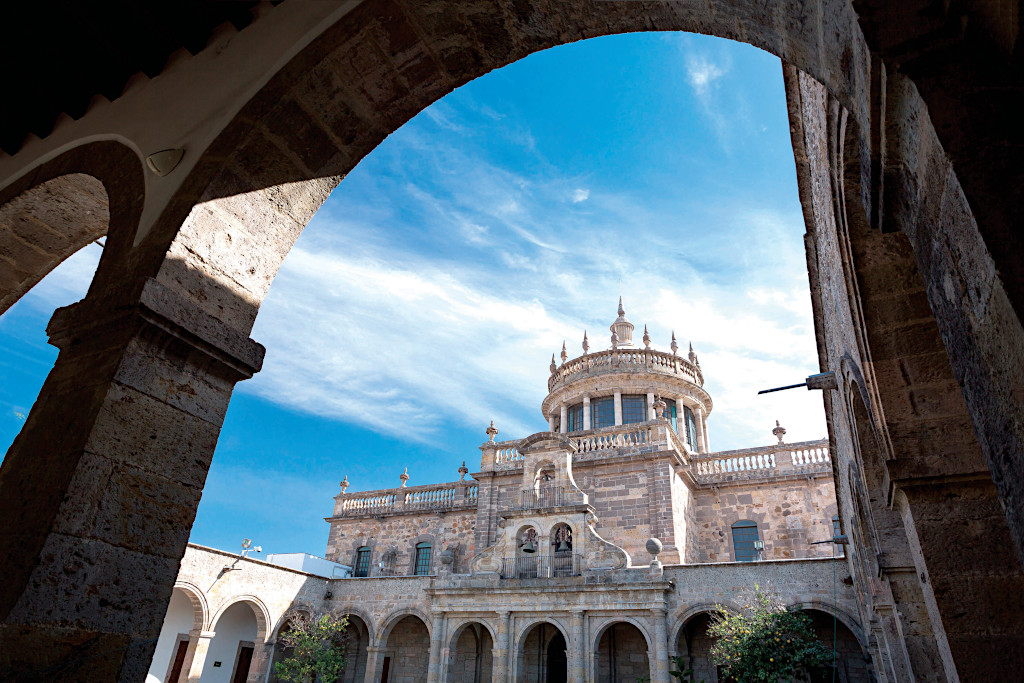JAL restaurant occupies the ground level of Hotel 1970 Posada’s beautiful seven-story central atrium, which is capped by a skylight and surrounded by the hotel’s 162 guestrooms. Each one is chic and decorated with wood features and textiles handmade locally. The rooftop’s Se7enta is an indoor-outdoor sky bar with small bites, a firepit, and city views.
As the capital of the state of Jalisco, Guadalajara is rich with culture that dates back centuries. In the 1530s, Spanish explorers moved into the area, then situated between several pre-Hispanic settlements. The Spanish colonists established the city’s basic infrastructure, erected the Guadalajara Cathedral (which has been rebuilt a few times), and started industries that flourished thanks to rail lines linked to the United States. In Mexico, only Mexico City rivals Guadalajara’s strong economy, and its success shows across the metropolis with plenty of arts and culture.

Guadalajara Central Cathedral (Cathedral of the Assumption of Our Lady), in Jalisco, Mexico
Photo: eskystudio
In the Centro, I got to discover some of the city’s marvels with the help of Liliana Barragan of Dragonfly Tours (dragonfly.pro). She explained more about Guadalajara’s layered heritage, beginning with the Regional Museum of Guadalajara (Calle Liceo 60. Tel: 52-33-3613-2703. inah.gob.mx/red-de-museos/204-museo-regional-de-guadalajara), a 1701 colonial structure that’s been Jalisco’s natural history, art, and artifact reliquary for more than a century.
Next she invited our small group to peek into the 19th century, neoclassical Teatro Degollado (Av. Hidalgo y Morelos. sc.jalisco.gob.mx/patrimonio/teatros-y-foros/teatro-degollado), where the high notes of classical opera and philharmonic seemed to cling to the velvet seats. Outside on Plaza de la Liberación, she explained more about Mexican revolutionary Miguel Hidalgo, who stands proudly in bronze, poised to fight. His zealous depiction contrasts the lighter vibes of the giant pink-and-white “Guadalajara Guadalajara” signs, meant to evoke the classic mariachi song recorded by dozens of singers, including Elvis Presley in 1963.
We strolled down Paseo Hospicio (aka Plaza Tapatía), a pedestrian shopping promenade that’s heavy on knockoffs, and dotted with historical markers, fountains, and other sights that only a savvy tour guide knows to point out.
In Liliana’s capable hands, we soon arrived at Museo Cabañas (Calle Cabañas 8. Tel: 52-33-3668-1642. museocabanas.jalisco.gob.mx), perhaps the most famous and striking museum in town. The former 18th-century orphanage is today a large art museum and events space, and a UNESCO World Heritage Site thanks to its magnificent, dramatic Orozco ceiling and wall murals. I could have spent hours staring up at them, following the artist’s detailed visions of colonists vs. native people, paralleled by symbolic images of industry vs. nature. The sprawling murals are all the more fascinating knowing that Orozco lost his left hand and damaged his left eye in a fireworks accident at age 21, and still went on to create such masterworks.

Women Stunt Riders at the Charreria Rodeo
Photo: T photography
Departing this iconic museum, we crossed Calle Dionisio Rodriguez to visit Latin America’s largest indoor market, the Mercado Libertad – San Juan de Dios, housing five stories and some 3,000 stalls. It can be overwhelming at first, and the wares are endless. Head here for cowboy gear, silver jewelry, leather ware, household goods, fresh produce, toys, souvenirs, dried edible crickets, and even voodoo supplies. Just don’t miss the third-floor food stands, which drew me in for succulent tacos (fish and meat), ceviche, fresh juices, jericalla (Jaliscan flan), and birria (spicy goat or mutton stew).
By comparison, local gastronomy also comes as a memorable sit-down tasting experience at Xokol Antojeria (Calle Ignacio Herrera y Cairo 1392. Tel: 52-33-1229-9085), in Santa Teresita. The menu here changes weekly, but one thing that’s consistent are its corn-based dishes and drinks, which channel its co-chefs’ ancestral heritage. The food is incredible, but the restaurant is tiny, so reserve well in advance to try Xokol’s inventive cuisine.
From art, shopping, and dining on Saturday, it was time to enjoy some horsing around on Sunday morning at Campo Charro Jalisco (Av. Dr. Roberto Michel 577. Tel: 52-33-3619-0315) in San Carlos. The Mexican rodeo known as “charrería” is not just the country’s national sport, it’s a UNESCO-designated cultural event that began with 16th-century herdsmen culture. As they do nearly every Sunday at noon, charros (cowboys) from around the state head to this small stadium near Parque Agua Azul to show off their horse-riding skills and tricks. For me, the highlight was escaramuza charra, the female stunt-riding team of about a dozen side-saddled women who perform synchronized routines.

Torta Ahogada
Photo: Carolina Arroyo
Afterwards, I headed to Avenida Chapultepec in the neighborhood called America to stroll its shady promenade, reminiscent of Barcelona’s La Rambla for its broad array of cafés, boutiques, and public art. Then it was time for an early dinner at trendy Anita Li (Av Inglaterra 3100. Tel: 52-33-3647-4757. anitali.mx) one of my new favorite restaurants, which is in located in the Vallarta neighborhood. Clad in vivid tones of teal, Anita Li is an airy, urban restaurant that seems to channel beach shacks; flavors of Thailand and Vietnam; and Mexican gastronomic traditions. It’s a sweet spot for lunch or dinner, or to sip cocktails that may mix in anything from pisco, Aperol, and cassis to ancho chiles, aromatic herbs, and fresh fruit. BTW, Anita Li spelled backwards is I Latina, which happens to be the name of its equally charming sister restaurant down the block (Av Inglaterra 3128. Tel: 52-33-3647-7774).
My final day began with a strong Mexican hot chocolate and chilaquiles verdes at Café P’al Real (Calle Lope de Vega 113. Tel: 52-33- 1983-7254) in Arcos Vallarta, whose open-air dining room is inviting for any meal of the day.
Then I ventured into the historic old town known as Tlaquepaque, where narrow lanes are lined with technicolor buildings divvied up by quaint plazas. Though you’ll find Insta-worthy sights around every corner on an average day, come Dia de Muertos week, be ready for catrinas overload. I couldn’t believe the mastery of face painting and elaborate costumes here, like Mexican Mardi Gras with even more colors and sequins.
As night began to fall, I met friends at Casa Luna (Calle Independencia 211. Tel: 52-33-1592-2061. facebook.com/CasaLunaRest) for a menu of “Mexican haute cuisine” and refined libations. I sipped a mezcal concoction from a hand-painted bowl and listened to a mariachi trio, absorbing nouveau spins on traditional Jaliscan food and culture. I felt the new and old coexisting in Guadalajara, a beautiful, complex city with modest charms and fiery fun.


